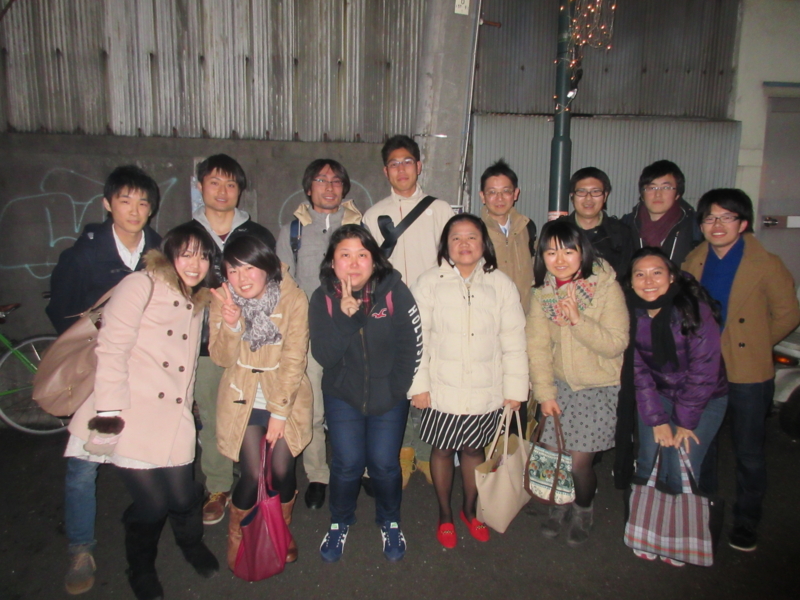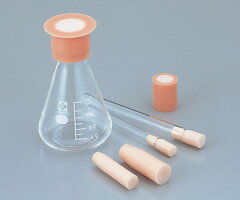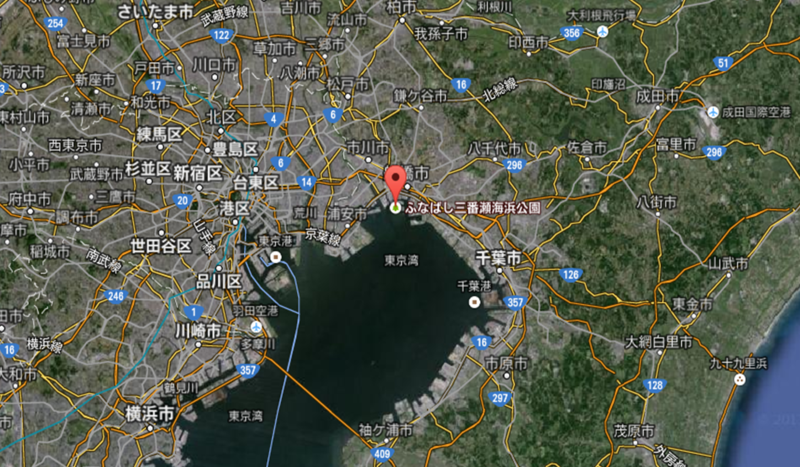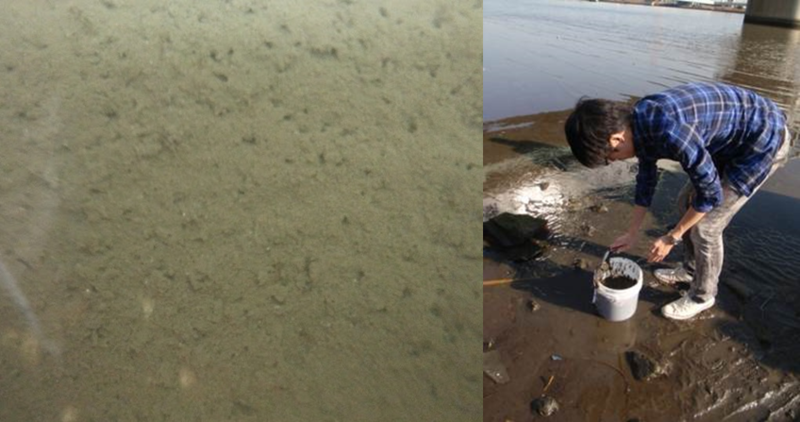ヨコエビの飼い方 part 2
This article is about the procedure of keeping aquarium for an amphipod, Grandidierella japonica, in our laboratory. Part 1 is here.

●飼育槽の維持・管理-その①:水換え-
飼育槽の海水は、毎週新しい海水に交換しています。pHが7.5-8.5、塩分濃度が約30‰になるよう調整しています。pHが7.5以下ならば、曝気不足・過密などによる溶存酸素の低下・二酸化炭素の過剰が生じているかもしれません。その際は、一時的な対策として海水の交換を、抜本的な対策としてポンプの修理・ヨコエビの間引きなどをおこなう必要があります。
The seawater in culturing aquariums is changed to the new one every week, to maintain pH between 7.5-8.5 and salinity around 30‰. If pH is below 7.5, the dissolved oxygen concentration may be low due to overcrowding or lack of air supply. If so, you have to change seawater, improve aeration system and decrease the number of amphipods.
海水を交換する時はエビを洗い流してしまわないように、250 μmのふるいを使用します。
A filter of 250 μm mesh size is used to prevent flushing out amphipods.

●飼育槽の維持・管理-その②:餌-
餌は熱帯魚飼育用のTetraMinを、週3回250 μmのふるいを通過するサイズにまで砕いてから与えています。与える餌の量は水槽内のヨコエビの数次第ですが、1回あたりヨコエビ1匹につき1~2 mg程度を目安としています。
TetraMin, commercial fish food, is grounded with a mortar and pestle. A fraction of less than 250 μm is fed to amphipods three times a week. Approximately 1~2 mg of TetraMin is fed to one amphipod per one feeding time.


K. HIKI
See you, Dahlia san!
研究員として7月から本研究室に在籍されたDahliaさんが、母国のフィリピンに帰られました。
Dahlia san worked as a researcher in our laboratory for around 6 months. She went back to her home country Philippine last week.
Dahliaさん、 短い間でしたがありがとうございました。特に研究室ミーティングではDahliaさんがいくつも鋭い質問をして下さって、より盛り上がったと思います。
Dahlia san, thank you very much for everything. I especially appreciate her fruitful comments and questions in Lab meeting.
本研究室でおこなった生態毒性の研究が、もし帰国後も役に立つならうれしいですね。
I'd be grateful if her experience in our laboratory could be useful to her research after going back to Philippine.

Dahliaさんの送別会での写真
K.HIKI
オートクレーブ内に活性汚泥をぶちまけてしまった!
どうも、日置です。
昨日、活性汚泥をガラス瓶に入れてオートクレーブにかけました。するとガラス瓶が割れて、汚泥をオートクレーブの中にぶちまけてしまいました。
I tried to sterilize activated sludge with an autoclave yesterday. Glass bin, in which activated sludge was contained, was broken. Sludge was scattered inside the autoclave.

オートクレーブを使う際は、瓶の内圧が高くなりすぎるので、瓶のふたを緩めて圧を逃がさないといけません。今回は、緩めるのを忘れていたっぽいです。
I may have forgotten to loosen the cap. That's the cause of the accident.
今後同じ過ちを繰り返さないために、①オートクレーブに「ふたを緩めろ」的な注意をでかでかと書く*1、②ふたの上にアルミホイルをかぶせる作業をはさんで、ふたに注意が行くようにする、③そもそもシリコ栓を用いるなどの対策をしようと思います。

▲シリコ栓(アズワンのページから)
オートクレーブ内は水道水で洗浄しましたが、もしまだ臭かったらすみません・・・。
Many people helped me with cleaning. Thank you very much! However, if you still smell swege-like odor around the autoclave, let me know... . I'll clean again.
K. HIKI
*1:実はすでに注意書きはありますが。
ヨコエビの飼い方 part 1
こんにちは、日置です。
当研究室では、ニホンドロソコエビ(学名:Grandidierella japonica)というヨコエビを飼育しています(関連記事は→こちら)。今回は、ニホンドロソコエビの飼育方法・飼い方について紹介します。
I introduce the procedure of keeping aquarium for an amphipod, Grandidierella japonica, in our laboratory.

▲亜成体のニホンドロソコエビ(Grandidierella japonica)
●きちんとした飼育が大切!
ヨコエビを飼育している目的は、「彼らの応答を指標として、有害物質が生態系に与える影響を評価すること」です。なので、ヨコエビの生理生態自体が研究対象という訳ではありません。
Our objective is to evaluate the effect of pollutants on ecosystem using the amphipod, not to study the amphipod itself.
とはいっても、ヨコエビの飼育が上手く行かなければそもそも何も始められませんので、飼育方法・飼育環境は常に注意を払わなければならない点でもあります。(手を抜きがちな点でもありますが・・・。)実際、学会等で環境生態毒性を研究されている方とお会いした時、試験生物の飼育法(コツとか?)は結構盛り上がる話題です。
However, keeping the amphiod healthy is the most basic requirements for our research. How should we keep aquariums for test species? That's a great concern to many ecotoxicology researchers, I think.

▲ヨコエビの飼育槽
●ヨコエビはどこから採ってきたのか?
飼育しているニホンドロソコエビは、先輩方が千葉県の三番瀬干潟から採取して下さったものです。研究室の水槽で、ヨコエビ何世代にも渡って飼育しています。
The amphipods used in our laboratory were collected from a tidal flat in Chiba, Japan.

●飼育槽に何を入れる?-その①:海水-
飼育しているニホンドロソコエビは海域・汽水域に棲むヨコエビです。そのため、飼育槽には海水または汽水を入れなければなりません。(ヨコエビには淡水産の種もたくさんいます。)
Grandidierella japonica is the marine and estuarine species, thus seawater was added to culturing aquariums.
海水を入手する方法は、「人工海水の素」のような製品から作る、近くの海から採取するなどがありますが*1、本研究室ではUSEPA(米国環境保護庁)の定めた作成法に従って、塩化ナトリウムや塩化マグネシウムなどから人工海水を作成しています。
We use artificial seawater including nine kinds of compounds such as NaCl and MgCl2.

▲海水を貯めているタンク
●飼育槽に何を入れる?-その②:底質-
ニホンドロソコエビは底質に穴を掘って、その中で生活します。そのため、飼育槽には、河川から採取した底質をふるいにかけてから入れています*2。底質は砂っぽいものよりは、泥っぽい有機含量の多いものの方が繁殖しやすいみたいです。
Field sediment has been added to culturing aquariums, becuase G. japonica buries in the sediment. They prefer fine sediment to coarse one.
下の写真でたくさん空いている小さな穴が、ヨコエビの巣穴?です。夜になると、穴から出てきて泳ぎ回る姿も確認できます。
The picture below is amphipods' tubes in the sediment. They swim out of tubes at night.

▲底質に見られる穴(左)と底質採取のようす(右)
続く・・・(→こちら)
to be continued... (→Part 2)
K. HIKI
今学期(2014冬)の研究室ミーティング
こんにちは、日置です。
今学期も本研究室では、所属教員・研究員・学生が集まってのミーティングをほぼ毎週行います。(前学期のミーティングに関してはこちら参照。)
In this semester, Lab Meeting will be held to share the knowledge of each student/researcher. All students and researchers in our laboratory are expected to attend this meeting.
●スケジュール Schedule
今学期のミーティングは文献紹介と、各自の研究進捗報告の二部構成で行う予定です。スケジュールは下の通りです。
Almost every meeting is consisting of two parts; "Reviewing papers" and "Research progress". The schedule is as follows.

原則、毎週金曜日の16:40からの90分間です。本研究室の方以外でも、もし興味のある方がいらっしゃいましたら、ご参加いただければ幸いです。
This meeting starts at 4:40 PM, Friday. If you are interested in our activity, please join us.
K. HIKI
●追記 (2015.01.30)
ミーティングで紹介された論文は下記のものです。下のリストを見れば、今の本研究室がどのようなことに興味を持っているか、おおよそ分かるかもしれません。
Papers reviewed in this meeting was following:
- Tan C.H. et al., 2014, The role of quorum sensing signaling in EPS production and the assembly of a sludge community into aerobic granules, IMSE J., 8, 1186-1197.
- Dong M.M. and Rosario-Ortiz F.L., 2012, Photochemical formation of hydroxyl radical from effluent organic matter, Environ. Sci. Technol., 46, 3788-3794.
- Schlekat C.E. et al., 2010, Cross-species extrapolation of chronic nickel biotic legand model, Sci. Total Environ., 408, 6148-6157.
- Ratpukdi T. et al., 2009, Rapid fractionation of natural organic matter in water using a novel solid-phase extraction technique, Water Environ. Res., 81, 2299-2307.
- Turesson E.U. et al., 2007, Development and reproduction of the freshwater harpacticoid copepod Attheyella crassa for assessing sediment-associated toxicity, Aquat. Toxicol., 83, 180-189.
- Jiang W. et al., 2013, Effect of quorum quenching on the receptor performance, biofouling and biomass characteristics in membrane bioreactors, Water Res., 47, 187-196.
- Yang X. et al., 2014, Sunlight-induced changes in chromophores and fluorophores of wastewater-derived organic matter in receiving waters–The role of salinity, Water Res., 62, 281-292.
- Webb G. et al., 2011, Efficacy, environmental ersistence and non-target impacts of pyriproxyfen use against Aedes viilax in Australia, Proc. 7th Inter. Conf. Urban Pests, 151-170.
- Ralston‐Hooper K.J. et al., 2011, Use of GC× GC/TOF‐MS and LC/TOF‐MS for metabolomic analysis of Hyalella azteca chronically exposed to atrazine and its primary metabolite, desethylatrazine, J. Applied Toxicol., 31(5), 399-410.
- Garcia-Reyero N. et al., 2012, Assessment of chemical mixtures and groundwater effects onDaphnia magna transcriptomics, Environ. Sci. Technol., 46, 42-50.
Study in Chalmers University of Technology
こんにちは、M1の柳原です。ご無沙汰しております。夏休みの間SwedenのChalmersにて、本研究室の卒業生であるModin先生のもと研究をしていました。研究室とは直接関係がありませんが、良い経験をしたので紹介します。
Hi, I am Miina. I stayed in Chalmers University of Technology for five weeks this summer. I would like to introduce this experience.
●研究概要:Microbial Electrolysis Cellの効率を上げるには?
普通、微生物の力を使って下水処理を行いますが、その過程で水素を発生させようという研究です。下水(=廃棄物)からエネルギー(=有価物)を取り出す、という何とも素敵な現象を扱うことができて、良い経験となりました。最後にプレゼンで成果を報告し、中島先生もセミナーで研究の紹介を行いました。
My research topic was about Microbial Electrolysis Cell, which can generate hydrogen gas from wastewater by using specific microorganisms. It means recovery something benefitial from waste, thus this technology may have an important role for creating sustainable society. In the last week of my stay, I and Prof. Nakajima gave presentations about our research progress.

△セミナーの様子 先生方、PhDの方々が出席なさいました。
●生活面:緑豊か・コーヒー・居心地のよい家具・塩味とポテト
木々が多く気持ちよく過ごせる場所でした。Swedenに住みたい方はコーヒーへの耐性をつけましょう。青色と黄色の看板でお馴染みの家具屋さんはスウェーデン発です。どの椅子も座り心地がよかったです。食事に関しては、慣れが必要でしたが学食のメニューが好きでした。(例:ミートボール+マッシュポテト+サラダバイキング+パン数切れ+ドリンク)また機会があれば、ぜひ訪れてみたいです!
Besides the research, I really enjoyed Swedish life; full of nature, coffee, comfortable furniture and salty foods with potato. I want to visit Sweden again!

△植物園の中の保護区を散歩中に見つけた毒きのこ。ちょうどきのこの季節が始まったころで、いたる所で見かけました。
We cannot eat this mushroom, but it is beautiful. The season for mushroom started.
それではまた!Hej då!
M. Yanagihara
Suthidaさん、ご卒業おめでとうございます!
昨日9/26(金)は卒業式でした。本研究室からは、D3のSuthidaさんが博士課程を修了されました。おめでとうございます!
Yesterday, graduation ceremony was held. Suthida san completed doctoral course work. Congratulations!

▲Suthidaさん ご卒業おめでとうございます! 山本先生と中島先生、福士研の三浦君と。
Suthidaさんは排水の膜処理の研究をされていました。特に、膜の公称孔径よりも大きいバクテリアが膜を通過するという現象を扱っていました。発表の中で使われていた、バクテリアが細管を通り抜ける動画がとても印象的でした。
Her research topic was "bacterial leakage potential through microfiltration membranes". Her movie presentation, in which bacterial suspension was passing through channels, was very impressive.
ご卒業後はタイに帰国し、就職される予定とのことです。今後のご活躍をお祈りしております。今まで大変お世話になりました!
After graduation, she will go back to Thai. I wish you all the best for your future career. Thank you very much for everything that you've done for us!
K. HIKI